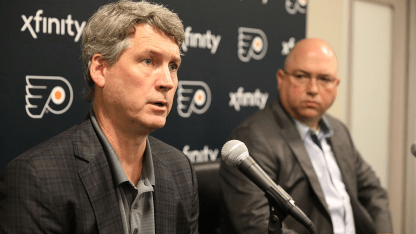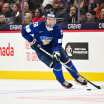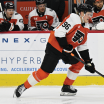Flyers general manager and team president, along with assistant general manager and vice president Brent Flahr, had a video conference call with reporters on Tuesday. They discussed a wide array of topics, ranging from the 2020 NHL Draft on Oct. 6-7, the start of free agency season on Oct. 9, the club's own impending restricted and unrestricted free agents and incoming rookies slated to play their first pro season in 2020-21.
Below are four key takeaways from Tuesday's session.
Fletcher & Flahr: 4 Takeaways
Flyers general manager and team president, along with assistant general manager and vice president Brent Flahr, had a video conference call with reporters on Tuesday

By
Philadelphia Flyers
philadelphiaflyers.com
- Draft: BPA Early, Fill Depth Needs Later
Flahr reiterated that the organization is unlikely to use its first round pick to target a player who plays a certain position or plays a particular style (sniper, playmaker, two-way forward, puck-moving defenseman, etc.). The team will instead take the top player available on the organization's internal rankings when the 23rd overall pick of the first round is the next on the board.
There's one caveat, however, in the event two players who are considered virtually interchangeable in their projected future depth chart spot in the NHL relative to their positions are both still on the board. This scenario is unlikely at 23rd overall, but not impossible.
"If players are equal, we may look for different positions, different needs. At the same time, I think we have to go with best player going forward. We'll look at a number of different scenarios and what falls to us. In reality, we'll go with best player available at 23," Flahr said.
The assistant GM added that, targeting certain positions or characteristics in order to bolster organization depth in desired areas is more likely to weigh into some of the picks made in later rounds of the Draft.
"With our depth chart, you can take a look at it. In left defense, we have some players coming. In right-shot defense, we're getting a little thinner. We can maybe address that if it makes sense. Sometimes there's just not players available when you are picking. Obviously up front, whether it's scoring, would be something you want to address and it's something you like to address every year. I don't think it changes much. We'll see how it plays out. We have guys targeted at each tier of the draft. We'll try to do the best we can based on that," Flahr said.
Fletcher was asked if the organization might look to trade up to an earlier spot in the first round, trade down to acquire an additional Draft pick while still likely being able to land the first or second still-available pick on the internal rankings or perhaps to trade the first-round pick entirely as a piece in a trade for an NHL roster player.
The GM, unsurprisingly, said that all options will be considered along with simply standing pat and using the 23rd pick.
"It's really going to depend on how our list shapes up. You sort of look at it. There's different groupings of players, even more so in how you number them. If you have a chance to move up into a higher group, you've got to look at it. Having said that, based on our preliminary thoughts at 23, we think there's going to be somebody we fall to us that we like. There may be several players that fall to us that we like, in which case we can entertain moving back, Fletcher said.
"I don't want to handicap it, but you're more likely to move back than you are to move up, just based on how we feel the draft will break with respect to our list. It only takes one or two players to still be there that you thought might go in the top 12 or 15 and then you are looking for ways to get up. It's a deep enough draft where I anticipate we're going to be pretty happy with some of the players that are on the board."
There was also a question pertaining to the organization's level of risk tolerance in the first round, and whether the Flyers might be a little more willing to roll the dice on a player with a potentially higher offensive ceiling but a potentially lower NHL floor due to defensive issues, injury histories, skating concerns or other factors that can cause a player to fall further than some pre-Draft projections slotted the prospect's likely selection range.
Flahr's response was that risk factors are part of the equation that weighs into an organization's pre-Draft ranking. He did not think the organization's level of risk-tolerance for 2020 is different than in other Draft years.
"There are certainly players that are more risky when taking them. Some maybe have skating issues, or character issues or whatever. When we do our lists, when we put it in order, we take all those things into account when we get going [on rankings]," Flahr said.
Obviously, if there's tremendous upside of a player and we feel confident that we can help this player to get where he needs to be, then we will draft him. If the concerns are so significant that our scouts and staff don't feel comfortable with it, then we fold. In reality, that's how we make our list every year and I don't think it changes this year."
One thing that is a top priority to general manager Fletcher: He wants internal consensus on the top 20 available prospects before the Draft starts, even if the actual selection order varies. There shouldn't be any last second fist-politicking or fist-banging to go off the internal board on a non-consensus candidate in the first round.
"You work so hard on your list. I've always told our scouts that I like to pick the first twenty picks in [some] order for sure. I hate when there's debate at the table in the first round. We should be prepared. We have all year to prepare. Let's get our draft together. Let's spend weeks and weeks beating it up and getting that list. We should know exactly what we are looking at when our pick comes and that allows me to know whether we need to move up or move back. We'll stick to that philosophy this year. There's a lot of skilled players available. I'm confident we'll get a player with a high-level skill with our pick whenever that pick is," Fletcher said.
2. Internal RFAs are the first signing priority
The Flyers have already gotten most of their would-be restricted free agents signed to contract extensions: Oskar Lindblom, Nicolas Aube-Kubel and Robert Hagg. The only remaining ones are Philippe Myers and Nolan Patrick. Fletcher said that it is by design to take care of the RFAs first, when possible.
Fletcher declined to comment on the status of negotiations with Myers or Patrick, including the term of potential deals, other than saying there is dialogue underway.
In regard to Patrick's health, Fletcher repeated his recent comment that Patrick continues to make progress and the GM is optimistic that the center will make a healthy return to the Flyers in 2020-21, However, he cannot put a timetable on it right now. This is light not only of the fact that Patrick has not been in a full-contact process since late in the 2018-19 season but also due to the leaguewide uncertainty about when the 2020-21 season will start.
Fletcher was also asked about the club's remaining unrestricted free agents: Brian Elliott, Justin Braun and Tyler Pitlick.
"I've had preliminary conversations with the all the agents for the UFAs on our team. What I've kind of indicated to all of them is that I wanted to speak to every team in the league at the end of the season. I wanted to get a sense where our RFAs, what the market will be for them in terms how much of a cost for us to re-sign them. I wanted to give our staff a couple weeks to decompress before we got into our players. We're still going through the process," Fletcher said.
"It's been a real busy few weeks here. Starting to get a feel for what's available in the market in terms of trades. Starting to get a feel for what RFAs are looking for. Over the next week, we'll start to address our own UFAs and see if there's a fit. We've had some preliminary conversations with the agents. More importantly with this stage of the offseason, we've been doing a lot of due diligence and a lot of homework to assess what we really need to do."
3. Offseason activity will extend throughout the fall
Many years, there is a flurry of trade discussions -- only a fraction of which advance beyond tire kicking and then only a minority of the ones that become more substantive actually come to fruition -- before and during the Draft.
Shortly thereafter, there's usually a frenzy of free agent signings on the first and second days of free agency seasons, with things rapidly tapering off each subsequent day. Usually, in the latter stages of the offseason, there are a few potential bargain signings plucked off the remaining market as prices drop.
Fletcher said, given the flat cap considerations faced leaguewide as well as some teams that need to get to the cap floor, there is likely to be a high volume of trade discussions taking place (despite the fact that the 2020 Draft is being conducted remotely rather than in person).
In terms of free agency season, Fletcher said that, after the initial wave of signings, there would be sporadic upticks as well as late-offseason maneuvering for bargains. This will be driven by clubs' cap situations, shifts in market prices and the competing desires to be patient in tracking the marketplace without losing out on a chance to help fill a need on the NHL roster.
4. Incoming rookie forward trio will have a chance to compete for NHL time
During the NHL pause, the Flyers signed two collegiate draftees who'd played all four of their NCAA-eligible seasons and could have become unrestricted free agents this summer if they so desired: forwards Wade Allison and Tanner Laczynski. The organization lost prospect defenseman Wyatt Kalynuk to the Chicago Blackhawks via unrestricted free agency after he opted to forego his senior year at Wisconsin.
The Flyers also signed undrafted Swedish forward Linus Sandin to a one-year NHL contract. All three among Allison, Laczynski and Sandin are more experienced players than most typical rookies entering their first NHL camps. Sandin's case, the player has four seasons of pro experience in Sweden's top league (SHL). Flahr believes that Allison, Laczynski and Sandin will all come to training camp with the opportunity to crack the NHL roster, either right away or at some point within the 2020-21 season.
"They're older players [age 23 or 24). They're physically more mature than typically players that are coming out of junior that are 19-, 20-years-old. Their mindset coming to camp is to make the team. Whether they're ready for that, it's up to them and their performance. At the same time, we expect them to help and challenge the internal competition. In reality I would say, I would assume that each of them are going to play games this year. Hopefully one of them grabs it and makes the best of their opportunity," Flahr said.


















